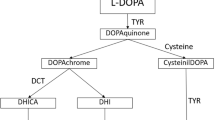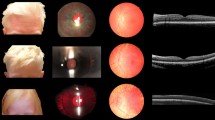Abstract
THE mouse pink-eyed dilution (p) locus on chromosome 7 is associated with defects of skin, eye and coat pigmentation1. Mutations at p cause a reduction of eumelanin (black-brown) pigment and altered morphology of black pigment granules (eumelano-somes), but have little effect on pheomelanin (yellow-red) pigment2. We show here that the human complementary DNA DN10, linked to thep locus in mice3–5, identifies the human homologue (P) of the mouse pgene, and appears to encode an integral membrane transporter protein. The expression pattern of this gene in various p mutant mice correlates with the pigmentation phenotype; moreover, an abnormally sized messenger RNA is detected in one mutant,pun, which reverts to the normal size in pun revertants. The human P gene corresponds to the D15S12locus within the chromosome segment 15qll–ql3, which is typically deleted in patients with Prader–Willi and Angelman syndrome (see ref. 5 for review). These disorders are phenotypically distinct, depending on the parent of origin of the deleted chromosome5–7, but both syndromes are often associated with hypopigmentation of the skin, hair and eyes (see ref. 8 for review), and deletion of theP gene may be responsible for this hypopigmentation. In addition, we report a mutation in both copies of the human P gene in one case of tyrosinase-positive (type II) oculocutaneous albinism, recently linked to 15qll–ql3 (ref. 9).
This is a preview of subscription content, access via your institution
Access options
Subscribe to this journal
Receive 51 print issues and online access
$199.00 per year
only $3.90 per issue
Buy this article
- Purchase on Springer Link
- Instant access to full article PDF
Prices may be subject to local taxes which are calculated during checkout
Similar content being viewed by others
References
Silvers, W. K. The Coat Colors of Mice. A Model for Mammalian Gene Action and Interaction (Springer, New York, 1979).
Russell, E. S. Genetics 34, 146–166 (1949).
Nicholls, R. D. Mouse Newsletter 84, 87–88 (1989).
Nakatsu, Y., Gondo, Y. & Brilliant, M. H. Mammal. Genome 2, 69–71 (1992).
Nicholls, R. D., Rinchik, E. M. & Driscoll, D. J. in Genomic Imprinting in Mouse and Man (ed. Surani M. A. & Reik, W.) Seminars dev. Biol. 3, 139–152 (1992).
Cassidy, S. B. Curr. Problems Pediatr. 14, 1–55 (1984).
Clayton-Smith, J. & Pembrey, M. E. J. med. Genet. 29, 412–415 (1992).
Nicholls, R. D. Am. J. med. Genet. (in the press).
Ramsay, M. et al. Am. J. hum. Genet. 51, 879–884 (1992).
Russell, L. B. Prog. Top. Cytogenet. 3, 205–250 (1983).
Melvold, R. W. Mutation Res. 12, 171–174 (1971).
Brilliant, M. H., Gondo, Y. & Eicher, E. M. Science 252, 566–569 (1991).
Wookey, P. J. & Pittard, A. J. J. Bact 170, 4946–4949 (1988).
Wang, H., Kavanaugh, M. P., North, R. A. & Kabat, D. Nature 352, 729–731 (1991).
Hearing, V. J. & Tsukamoto, K. FASEB J. 5, 2902–2909 (1991).
Sidman, R. L. & Pearlstein, R. Devl Biol. 12, 93–116 (1965).
Witkop, C. J. et al. in The Metabolic Basis of Inherited Disease Vol. II, 6th edn (ed. Scriver, C. R. et al.) 2905–2947 (McGraw-Hill, New York, 1989).
Tantravahi, U. et al. Am. J. med. Genet. 33, 78–87 (1989).
Fryburg, J. S., Breg, W. R. & Lindgren, F. Am. J. med. Genet. 38, 58–64 (1991).
Wallis, C. E. & Beighton, P. H. J. med. Genet. 26, 337–339 (1989).
Daumer, C. & Schuffenhauer, S. Med. Genetik. 3, 27–29 (1991).
Scrable, H. J., Johnson, D. K., Rinchik, E. M. & Cavenee, W. K. Proc. natn. Acad. Sci. U.S.S. 87, 2182–2186 (1990).
Rinchik, E. M., Machanoff, R., Cummings, C. C. & Johnson, D. K. Genomics 4, 251–258 (1989).
Rinchik, E. M. & Russell, L. B. in Genome Analysis Vol I (eds Dauies, K. & Tilghman, S.) 121–158 (Cold Spring Harbor Laboratory Press, New York, 1990).
Ullrich, A. et al. EMBO J. 5, 2503–2512 (1986).
Sambrook, J., Fritsch, E. F. & Maniatis, T. Molecular Cloning: A Laboratory Manual 2nd edn (Cold Spring Harbor Laboratory Press, New York, 1989).
Kyte, J. & Doolittle, R. F. J. molec. Biol. 157, 105–132 (1982).
Klein, P., Kanehisa, M. & DeLisi, C. Biochim. blophys. Acta. 815, 468–476 (1985).
Shibahara, S. et al. J. biol. Chem. 266, 15895–15901 (1991).
Lodish, H. F. Trends Biochem. Sci. 13, 332–334 (1988).
Dayhoff, M. O., Barker, W. C. & Hunt, L. T. Meth. Enzym. 91, 524–545 (1983).
Gardner, J. M. et al. Science 257, 1121–1124 (1992).
Author information
Authors and Affiliations
Rights and permissions
About this article
Cite this article
Rinchik, E., Bultman, S., Horsthemke, B. et al. A gene for the mouse pink-eyed dilution locus and for human type II oculocutaneous albinism. Nature 361, 72–76 (1993). https://doi.org/10.1038/361072a0
Received:
Accepted:
Issue Date:
DOI: https://doi.org/10.1038/361072a0
This article is cited by
-
Dedifferentiation maintains melanocyte stem cells in a dynamic niche
Nature (2023)
-
Novel deletion of exon 3 in TYR gene causing Oculocutaneous albinism 1B in an Indian family along with intellectual disability associated with chromosomal copy number variations
BMC Medical Genomics (2022)
-
P-Protein: A Novel Target for Skin-whitening Agent
Biotechnology and Bioprocess Engineering (2019)
-
Clinical evaluation and molecular screening of a large consecutive series of albino patients
Journal of Human Genetics (2017)
-
A deletion in the Hermansky–Pudlak syndrome 4 (Hps4) gene appears to be responsible for albinism in channel catfish
Molecular Genetics and Genomics (2017)
Comments
By submitting a comment you agree to abide by our Terms and Community Guidelines. If you find something abusive or that does not comply with our terms or guidelines please flag it as inappropriate.



